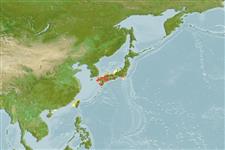Common names from other countries
>
Eupercaria/misc (Various families in series Eupercaria) >
Gerreidae (Mojarras)
Etymology: Gerres: Latin, gerres = a kind of anchovies; cited by Plinius; akazakii: Named for Dr. Masato Akazaki..
Environment: milieu / climate zone / depth range / distribution range
Ecología
marino; salobre demersal; rango de profundidad 2 - 3 m (Ref. 58476). Subtropical
Northwest Pacific: likely to be endemic in Japan.
Tamaño / Peso / Age
Maturity: Lm ? range ? - ? cm
Max length : 16.9 cm SL macho / no sexado; (Ref. 58476)
Short description
Morfología | Morfometría
Espinas dorsales (total): 10; Radios blandos dorsales (total): 9; Espinas anales 3; Radios blandos anales: 7
Known to inhabit the vicinity of river mouth basins, which may be considered strongly related to a minimum winter sea temperature of 16°C (less than 100 m depth). Specimens were collected in inlet basins, river mouth basins, or on shallow sandy bottoms strongly affected by freshwater from nearby river mouths. However, this species rarely occurs in the shallow coastal area with almost no freshwater effect. One specimen (MUFS 9584, 135 mm SL, 3 July 1993), had a clearly matured or water-hardened (transparent) egg, giving an indication of the spawning season of the species (Ref. 58476).
Life cycle and mating behavior
Madurez | Reproducción | Puesta | Huevos | Fecundidad | Larva
Iwatsuki, Y., S. Kimura and T. Yoshino, 2007. A review of the Gerres subfasciatus complex from the Indo-west Pacific, with three new species (Perciformes: Gerridae). Ichthyol. Res. 54(2):168-185. (Ref. 58476)
IUCN Red List Status (Ref. 130435)
CITES (Ref. 128078)
Not Evaluated
Human uses
Más información
Age/SizeCrecimientoLength-weightLength-lengthLength-frequenciesMorfometríaMorfologíaLarvaDinámica larvariaReclutamientoAbundancia
ReferenciasAcuiculturaPerfil de acuiculturaRazasGenéticaElectrophoresesheritabilidadEnfermedadesProcesamientoMass conversion
ColaboradoresImágenesStamps, Coins Misc.SonidosCiguateraVelocidadTipo de nataciónSuperficie branquialOtolitosCerebrosVisión
Herramientas
Special reports
Download XML
Fuentes de Internet
Estimates based on models
Preferred temperature (Ref.
115969): 20.2 - 24.3, mean 21.6 (based on 90 cells).
Phylogenetic diversity index (Ref.
82804): PD
50 = 0.5000 [Uniqueness, from 0.5 = low to 2.0 = high].
Bayesian length-weight: a=0.01413 (0.00602 - 0.03315), b=3.04 (2.86 - 3.22), in cm Total Length, based on LWR estimates for this Genus-body shape (Ref.
93245).
Nivel trófico (Ref.
69278): 3.3 ±0.3 se; based on size and trophs of closest relatives
Resiliencia (Ref.
120179): Alto, población duplicada en un tiempo mínimo inferior a 15 meses (Preliminary K or Fecundity.).
Fishing Vulnerability (Ref.
59153): Low vulnerability (11 of 100).
